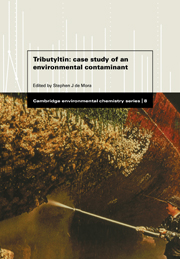Book contents
- Frontmatter
- Contents
- Contributors
- Preface
- 1 The tributyltin debate: ocean transportation versus seafood harvesting
- 2 Industrial manufacture and applications of tributyltin compounds
- 3 The analysis of butylated tin compounds in the environment and in biological materials
- 4 The occurrence, fate and toxicity of tributyltin and its degradation products in fresh water environments
- 5 The distribution and fate of tributyltin in the marine environment
- 6 Biological effects of tributyltin on marine organisms
- 7 TBT-induced imposex in neogastropod snails: masculinization to mass extinction
- 8 Environmental law and tributyltin in the environment
- 9 The efficacy of legislation in controlling tributyltin in the marine environment
- Index
3 - The analysis of butylated tin compounds in the environment and in biological materials
Published online by Cambridge University Press: 04 August 2010
- Frontmatter
- Contents
- Contributors
- Preface
- 1 The tributyltin debate: ocean transportation versus seafood harvesting
- 2 Industrial manufacture and applications of tributyltin compounds
- 3 The analysis of butylated tin compounds in the environment and in biological materials
- 4 The occurrence, fate and toxicity of tributyltin and its degradation products in fresh water environments
- 5 The distribution and fate of tributyltin in the marine environment
- 6 Biological effects of tributyltin on marine organisms
- 7 TBT-induced imposex in neogastropod snails: masculinization to mass extinction
- 8 Environmental law and tributyltin in the environment
- 9 The efficacy of legislation in controlling tributyltin in the marine environment
- Index
Summary
The origin and fate of butyltin compounds in the environment have been extensively studied in the past few years [1–6]. As described in Chapters 6 and 7 of this book, the toxicological impact of tributyltin (TBT) on marine organisms has been the major reason for a multitude of studies elucidating the biogeochemical pathway of this contaminant, together with its degradation products mono- and dibutyltin (MBT and DBT), in the environment. This interest and concern for the determination of butyltin compounds led to the development in the early 1980s of a wide variety of techniques which involve, in most cases, several different analytical steps: extraction, clean-up, derivatization, separation and final detection [7]. It is clear that accurate results for butyltin determinations is a prerequisite for good comparability of data and related studies on the toxicity and biogeochemical processes. However, the proliferation of multi-step techniques, although very sensitive, was not accompanied with the necessary awareness for the quality control of analysis. Only in the past five years has the availability of certified reference materials (CRMs), certified for their butyltin concentrations, allowed an improvement in the quality assurance of butyltin determinations in marine sediments. The overall quality of butyltin determinations is, however, far from being under control. Many techniques still need to be validated, some analytical steps (e.g. hydride generation) are often badly understood, and the number of CRMs is not sufficient to ensure a wide coverage of environmental and biological matrices.
- Type
- Chapter
- Information
- TributyltinCase Study of an Environmental Contaminant, pp. 62 - 93Publisher: Cambridge University PressPrint publication year: 1996
- 4
- Cited by



